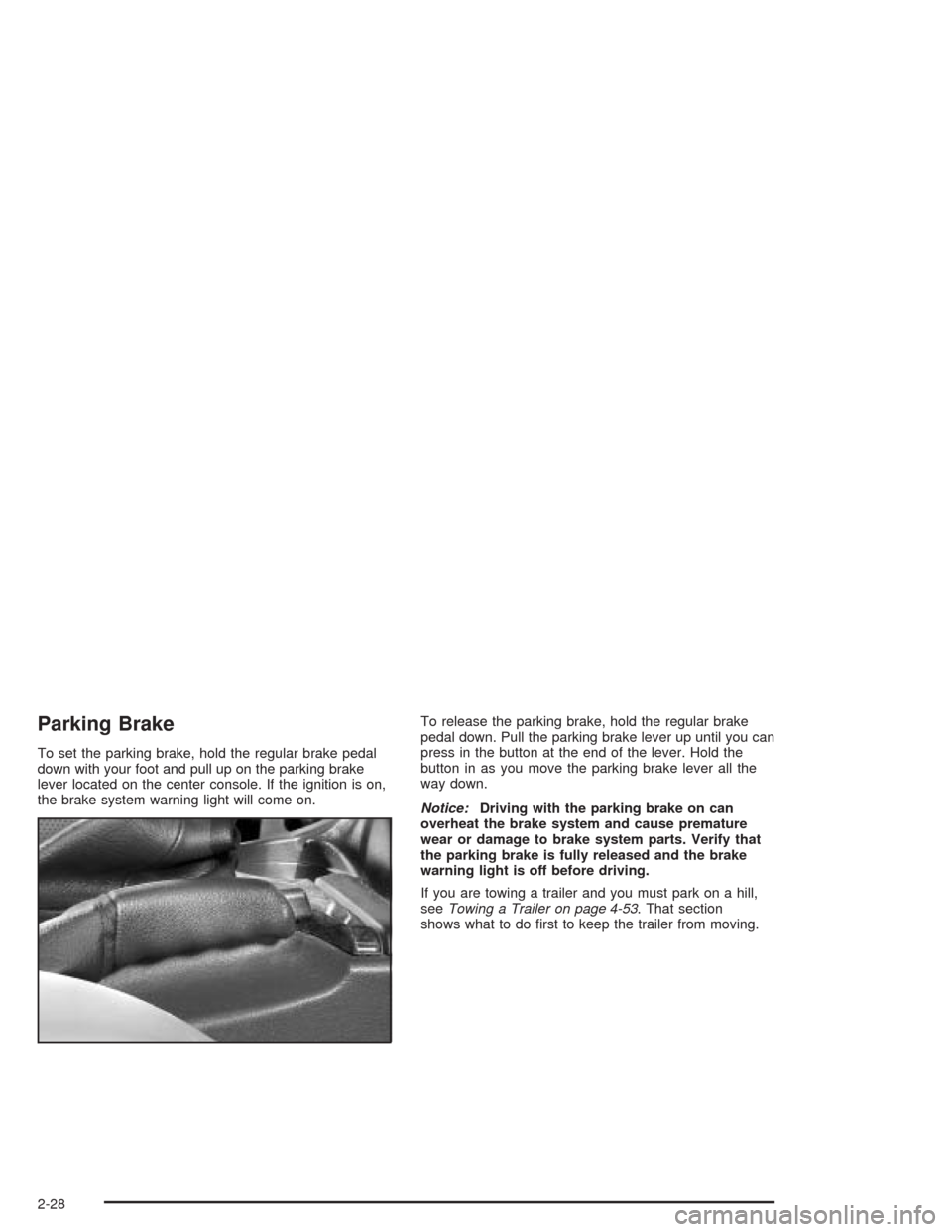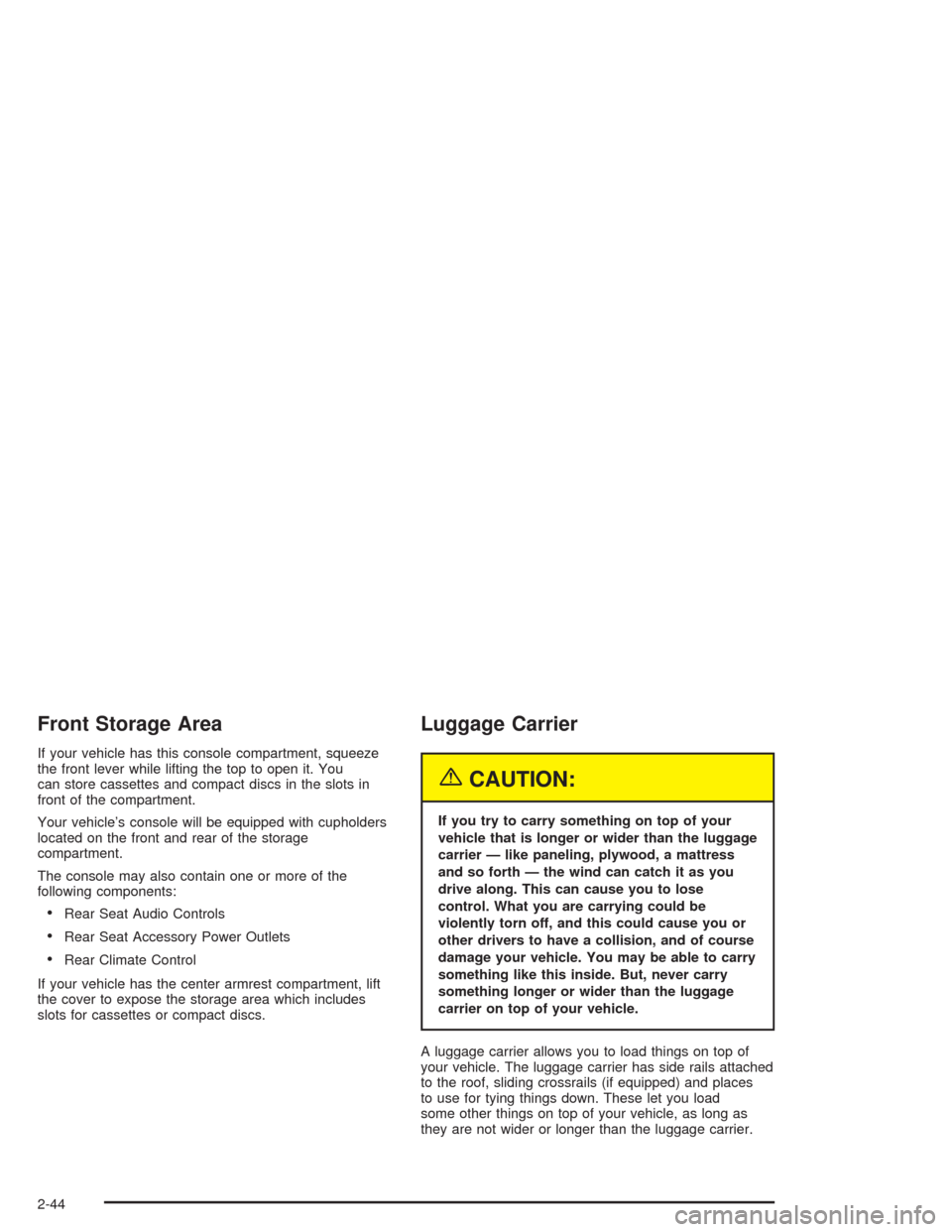center console CHEVROLET TRAIL BLAZER 2004 1.G Owners Manual
[x] Cancel search | Manufacturer: CHEVROLET, Model Year: 2004, Model line: TRAIL BLAZER, Model: CHEVROLET TRAIL BLAZER 2004 1.GPages: 448, PDF Size: 2.98 MB
Page 92 of 448

Parking Brake
To set the parking brake, hold the regular brake pedal
down with your foot and pull up on the parking brake
lever located on the center console. If the ignition is on,
the brake system warning light will come on.To release the parking brake, hold the regular brake
pedal down. Pull the parking brake lever up until you can
press in the button at the end of the lever. Hold the
button in as you move the parking brake lever all the
way down.
Notice:Driving with the parking brake on can
overheat the brake system and cause premature
wear or damage to brake system parts. Verify that
the parking brake is fully released and the brake
warning light is off before driving.
If you are towing a trailer and you must park on a hill,
seeTowing a Trailer on page 4-53. That section
shows what to do �rst to keep the trailer from moving.
2-28
Page 108 of 448

Front Storage Area
If your vehicle has this console compartment, squeeze
the front lever while lifting the top to open it. You
can store cassettes and compact discs in the slots in
front of the compartment.
Your vehicle’s console will be equipped with cupholders
located on the front and rear of the storage
compartment.
The console may also contain one or more of the
following components:
Rear Seat Audio Controls
Rear Seat Accessory Power Outlets
Rear Climate Control
If your vehicle has the center armrest compartment, lift
the cover to expose the storage area which includes
slots for cassettes or compact discs.
Luggage Carrier
{CAUTION:
If you try to carry something on top of your
vehicle that is longer or wider than the luggage
carrier — like paneling, plywood, a mattress
and so forth — the wind can catch it as you
drive along. This can cause you to lose
control. What you are carrying could be
violently torn off, and this could cause you or
other drivers to have a collision, and of course
damage your vehicle. You may be able to carry
something like this inside. But, never carry
something longer or wider than the luggage
carrier on top of your vehicle.
A luggage carrier allows you to load things on top of
your vehicle. The luggage carrier has side rails attached
to the roof, sliding crossrails (if equipped) and places
to use for tying things down. These let you load
some other things on top of your vehicle, as long as
they are not wider or longer than the luggage carrier.
2-44
Page 136 of 448

Accessory Power Outlets
Your vehicle may have accessory power outlets. With
the accessory power outlets, you can plug in auxiliary
electrical equipment such as a cellular telephone or CB
radio.
The �rst outlet is located to the right of the cigarette
lighter on the instrument panel. The second outlet
is located on the rear of the center console.
Remove the cover from the outlet to use the outlet. Be
sure to put the cover back on when not using the
accessory power outlet.
Certain electrical accessories may not be compatible
with the accessory power outlet and could result
in blown vehicle or adaptor fuses. If you experience a
problem, see your dealer for additional information
on the accessory power outlets.
Notice:Adding any electrical equipment to your
vehicle may damage it or keep other components
from working as they should. The repairs would not
be covered by your warranty. Check with your
dealer before adding electrical equipment.
When adding electrical equipment, be sure to follow the
proper installation instructions included with the
equipment.Notice:Improper use of the power outlet can cause
damage not covered by your warranty. Do not
hang any type of accessory or accessory bracket
from the plug because the power outlets are
designed for accessory power plugs only.
Ashtrays and Cigarette Lighter
Your vehicle may have this feature. The ashtray is
removable and �ts into the front cupholder.
Notice:If you put papers or other �ammable items
in the ashtray, hot cigarettes or other smoking
materials could ignite them and possibly damage
your vehicle. Never put �ammable items in the
ashtray.
To remove the ashtray, pull the covered bin out of the
cupholder.
To use the lighter, press it in all the way, and let go.
When it’s ready, it will pop back out by itself.
Notice:Holding a cigarette lighter in while it is
heating will not allow the lighter to back away from
the heating element when it is hot. Damage from
overheating may occur to the lighter or heating
element, or a fuse could be blown. Do not hold a
cigarette lighter in while it is heating.
3-20
Page 442 of 448

Oil (cont.)
Engine.......................................................5-15
Pressure Gage............................................3-43
OIL PRESSURE LOW/STOP ENGINE...............3-58
Older Children, Restraints................................1-27
Online Owner Center........................................ 7-3
OnStar
®Personal Calling.................................2-38
OnStar®Services............................................2-38
OnStar®System.............................................2-37
OnStar®Virtual Advisor....................................2-38
Operating Your All-Wheel-Drive Vehicle Off
Paved Roads..............................................4-15
Other Warning Devices...................................... 3-6
Outlet Adjustment...................................3-23, 3-27
Outside
Convex Mirror.............................................2-37
Curb View Assist Mirrors..............................2-36
Heated Mirrors............................................2-37
Manual Mirrors............................................2-35
Power Mirrors.............................................2-36
Overhead Console..........................................2-43
Overseas – Customer Assistance........................ 7-4
Owner Checks and Services.............................. 6-9
Owners, Canadian............................................... ii
Owner’s Information........................................7-12
P
Parental Control............................................3-100
Park (P)
Shifting Into................................................2-29
Shifting Out of............................................2-31
Parking
Brake........................................................2-28
Over Things That Burn.................................2-31
Parking on Hills..............................................4-61
PASSENGER DOOR AJAR..............................3-59
Passing.................................................4-13, 4-59
Passlock
®......................................................2-17
Personalization...............................................3-51
Personalization, Climate Controls......................3-31
Plan Ahead When Possible................................ 7-7
Playing a Cassette Tape..................................3-81
Playing a CD.................................3-70, 3-83, 3-94
Playing a Speci�c Loaded CD..........................3-95
Playing the Radio...........................3-63, 3-73, 3-87
Power
Accessory Outlets........................................3-20
Door Locks.................................................. 2-9
Electrical System.........................................5-92
Lumbar Controls........................................... 1-3
Reduced Engine Light..................................3-45
Seat............................................................ 1-2
Steering Fluid.............................................5-35
Windows....................................................2-15
10
Page 445 of 448

Seats (cont.)
Rear Seat Operation...................................... 1-6
Reclining Seatbacks...................................... 1-4
Securing a Child Restraint
Center Seat Position....................................1-44
Designed for the LATCH System...................1-40
Rear Outside Seat Position...........................1-41
Right Front Seat Position..............................1-44
Security Light.................................................3-44
Security While You Travel.................................. 7-6
Select...........................................................3-57
Service........................................................... 5-3
Adding Equipment to the Outside of
Your Vehicle.............................................. 5-4
Doing Your Own Work................................... 5-4
Engine Soon Light.......................................3-40
Four-Wheel-Drive Warning Light.....................3-46
Publications Ordering Information...................7-11
SERVICE AIR BAG.........................................3-58
SERVICE BRAKE SYSTEM.............................3-58
Service Bulletins.............................................7-12
Service Engine Soon Light in the United States
or Check Engine Light in Canada..................3-40
Service Manuals.............................................7-11
Setting Preset PTYs (RDS Only).......3-66, 3-77, 3-91
Setting Preset Stations....................3-64, 3-75, 3-88
Setting the Time.............................................3-61
Setting the Tone (Bass/Treble)..........3-64, 3-75, 3-89
Sheet Metal Damage.......................................5-89
Shifting Into Park (P).......................................2-29Shifting Out of Park (P)...................................2-31
Skidding........................................................4-14
Snow Plow....................................................4-52
Some Other Rainy Weather Tips.......................4-31
Spare Tire.....................................................5-83
Special Fabric Cleaning Problems.....................5-84
Speci�cations, Capacities...............................5-104
Speedometer..................................................3-34
Stalling on an Incline.......................................4-25
Starting Your Engine.......................................2-20
Steering........................................................4-10
Steering in Emergencies..................................4-11
Steering Tips..................................................4-10
Steering Wheel Controls, Audio.......................3-113
Steering Wheel, Tilt Wheel................................. 3-7
Stereo RCA Jacks.........................................3-101
Storage Areas
Convenience Net.........................................2-48
Front Storage Area......................................2-44
Glove Box..................................................2-42
Luggage Carrier..........................................2-44
Overhead Console.......................................2-43
Rear Floor Storage Lid.................................2-47
Rear Storage Area.......................................2-45
Storing a Flat or Spare Tire and Tools...............5-80
Stuck in Sand, Mud, Ice or Snow......................4-42
Sun Visors.....................................................2-15
Sunglasses Storage Compartment.....................2-43
Sunroof.........................................................2-50
13